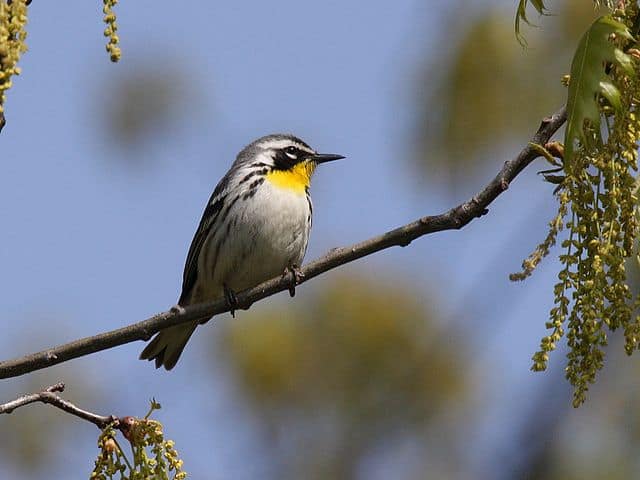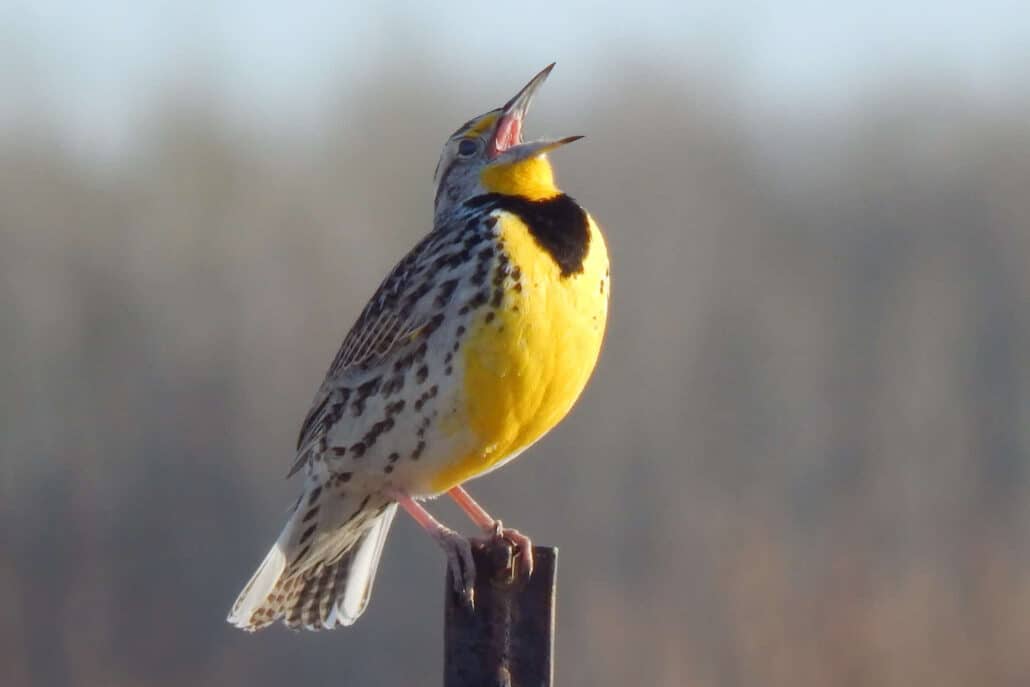Spring Birds of Iowa (March, April, May)
At dusk on a March evening, go out to a weedy field with brushy woods nearby, and listen. If you’re lucky, you’ll hear a nasal, resonant peent. Shine a flashlight in the direction of the sound, and you may spot an odd-looking, plump bird with an impossibly long bill, and with bulging eyes almost at the top of its head. This is the American woodcock, one of the earliest migrants to return to Iowa each year.
In early spring, birds that have spent the winter with us, such as cardinals, chickadees, and titmice, start singing before daybreak. Woodpeckers drum on trees (and sometimes on house siding), to proclaim their territories. But now the resident birds must share their habitat with migrants from the south. Early-arriving killdeer run around on fields barely thawed from winter’s freeze. Male red-winged blackbirds show up in wetlands and fields, several weeks before the females. Another early arrival, throughout all but northwestern Iowa, is the eastern phoebe. Because it sings its name, a burry, two-note fee-bee, and often builds its nest in sheltered nooks on buildings or beneath bridges over small streams, this is an easy bird to find in early spring, before the trees have leafed out.
In southern and central Iowa our large reservoirs host thousands of migrating shorebirds, waterfowl, and gulls. In the surrounding wooded areas, all the land birds are represented. In the lakes and marshes of the northern half of the state, waterfowl breed alongside nesting grebes, rails, and yellow-headed blackbirds. Any lake or farm pond may offer bed and breakfast in March for returning waterfowl. Migrating ducks fly in during the night, rest for the day or part of the day on a convenient body of water, and resume their journey to their nesting grounds in the North.
Keep an eye on those red-winged blackbirds. At first they are silent, concealing the colors on their wings and flocking in fields and wetlands. But as the urge to establish territories grows, they sing loudly from exposed perches and swell out their red-and-yellow epaulettes. Along the rural Iowa roads, male red-wings stand at attention like sentries on fence posts, each defending a territory where he will have one or several mates.
Purple martins return to Iowa in April. As throughout eastern North American, martins nest only in colonies, and only in birdhouses provided by humans. When they see the first martin, the birds’ human landlords open up their birdhouses, which had been closed through the winter to discourage starlings and house sparrows. Long before European settlers arrived on the scene, Native Americans hung gourds for martins to nest in, so the birds have a long history of cooperating with humans.
Chimney swifts also arrive in Iowa in April, suddenly filling the sky with their chittering. You’ll see two or three coasting through the air together, each with its wings held in a shallow V. Swifts originally nested in hollow trees that were open at the top. When the forests of eastern North America were cut, this species might have disappeared, but it was adaptable enough to adopt brick chimneys as substitute hollow trees and to accept people as co-tenants. Now chimney swifts are common in cities and towns throughout the state.
By April and May the influx of migrants is so rapid that each day a birder welcomes birds not seen for many months. And each day begins with a dawn chorus that may include, among many others, the flute-like songs of thrushes, the high, thin Old Sam Peabody of white-throated sparrows, the trills of chipping sparrows, chatter of house wrens, and the rollicking warbles of ruby-crowned kinglets. Listening to the urgent and varied songs of the dawn chorus, one feels the rush of the great planetary tide that is washing over the continent, filling every niche with song and color.
The backyard is a fine place to observe the season’s arrivals. Baltimore orioles whistle loudly from the trees (and may visit feeding stations for sliced oranges and grape jelly). In May, a male ruby-throated hummingbird, with his iridescent red gorget, reappears after his trip to Central America and hovers precisely where the sugar-water feeder hung the previous fall. Clearly, he’s come back to a place he remembers. In an unseasonable cold snap, rose-breasted grosbeaks, which usually stay out of sight, may suddenly crowd onto the feeder.
Grasslands fill with meadowlarks, field sparrows, grasshopper sparrows, and bobolinks. Poorly drained pastures with damp, weedy areas harbor swamp sparrows, snipes, and marsh wrens.
A walk through woods rewards the early riser with glimpses of thrushes—earliest in the season the hermit, then Swainson’s, gray-cheeked, and wood thrushes, usually near the ground. Yellow-billed cuckoos coo and clatter from hidden perches in the trees. A broad-winged hawk flies up suddenly out of the trees. Wood ducks wing through the woods and perch on a high branch. They will nest in a cavity in the tree.
Just as leaves unfurl and trees turn pale green, the tiny warblers and vireos appear. Their arrival coincides with the renewed activity of caterpillars and other small animal life in the foliage. In one of nature’s great feats of coordination, the birds find their food while defending the tender new growth from being devoured before the leaves can develop. In Iowa, 36 species of warblers enter the state in spring. Most of them are simply passing through, on their way north, and can be found in the state only for a few weeks. Although they are small, and many are hard to get a good look at in their treetop habitat, warblers are the jewel in the crown for birders. If you wish to join the fun, look for warblers early in the morning, especially in May. Since each warbler species sings differently from all the rest, learning their songs will be a great help. Furthermore, since you can hear birds sing even when they’re out of sight in the foliage, you’ll “see” more warblers with your ears than you can with your eyes.




